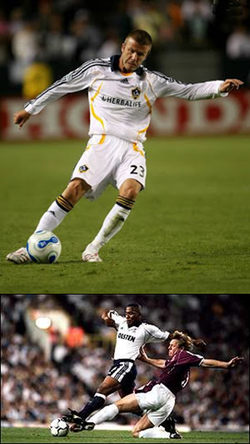
The paper offers some wonderful ideas for discussion. The authors present their ideas when motivating their study and discussing their results. Some of the reasons they suggest might lead two-footed players to be paid a premium are likely to get some opposition, as well support, from football fans.
There is a discussion about the relationship between mental and physical characteristics. One could fill an off-season with the possibilities!!! The authors rely on a paper by Kevin Denny and Vincent O’Sullivan that discusses the relationship between handedness and IQ. They proceed to link handedness to footedness and link IQ to sporting intelligence. This is super conversation material for sports fans. It might help explain why we hear commentators talk about players having “an educated left foot” but rarely hear about a player having "an educated right foot”. (One of the paper’s author is no stranger to the examining the link between measures of intelligence and sporting ability. A widely cited paper by Rob Simmons and David Berri examined the predictive power of the Wonderlic IQ test used on NFL quarterbacks.)
Another talking point from the 2013 Journal of Sports Economics paper is the claim that footedness is not important for goalkeepers. Bryson, Frick and Simmons classify players as defenders, forwards, goalkeepers, and midfielders. However, goalkeepers are dropped from their analysis. Why? According to the authors, “goalkeepers are excluded as footedness is not especially relevant for their performance”. Because of the availability bias, fans are likely to point to the high profile goalkeeping mistakes from a week ago – although both mistakes are not really about footedness. Southampton’s Artur Boruc gets his feet mixed up (view it here). Spurs Hugo Lloris has a poor clearance a couple of seconds into their game against Manchester City (view it here).
Let us return to the way the authors model defenders. Although the authors clearly say that being adept with both feet is an advantage, they do say there are some positions in which “being a predominately one-footed player could be an advantage”. The positions the authors list as possibly benefiting from a one-sided player are left-back and right-back. Why would a left-back or right-back be better off being predominately one-footed? Surely it is an unambiguous advantage to be two-footed. A two-footed player can do all the things a one-footed player can do. And, they can do a bit more.
So why can't the authors avoid the trap of claiming that a one-footed player might have an advantage in these defensive positions? I believe it arises from the common perception of the mental capacity of defenders. Rather than trusting the defender to make to appropriate decision about what foot to use (and associated decisions) the common perception is that the defender can't make these decisions correctly. Maybe a two-footed defender is over confident and misjudges the risk-return trade-off. This would explain why a well-worn phrase in sport is "Keep it simple, Stupid".
 RSS Feed
RSS Feed